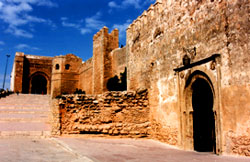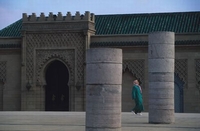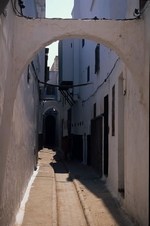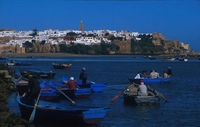|
Rabat, the white capital, was built above a river that acts as a mirror. Reflected in it today are the centuries rich in history, which made this ancient Almohade city the most imperial of imperial towns: the Royal town.
Established at the mouth of Bou Regreg, Rabat is the administrative and political capital of the Kingdom.
The Royal Palace lies right in the heart of Rabat, the seat of government and all the ministries. Sheltering behind its ramparts, it has the appearance of a place with a temperate climate, a peaceful, almost provincial, atmosphere. 
With the charm of the Oudayas gardens, the grandeur of its monuments, the magic of the Chellah necropolis, the immensity of its golden beaches, the incomparable splendour of the Dar-es-Salam Golf Club, Rabat is not just royal for its inhabitants, but for each of its visitors.
Allow your imagination to roam freely along the vast esplanade around the Hassan Tower. It is 44 metres (140 feet) high, but just imagine, it was originally intended to attain 86 metres (260 feet)! Majestic but never finished, the tower was the brainchild of sultan Yacoub el Mansour whose ambition was to build the biggest masque in the Muslim world. Two-hundred columns mark out where it was to stand, reflecting the glory of the Almohad empire which, in the 12th century, stretched as far as Tunisia and Moorish Spain.
A stone's throw from the Hassan Tower, but separated by many centuries, stands the Mohammed V Mausoleum, the construction of which began in 1962. This sultan led Morocco to independence and the country built a sumptuous monument to him to express its gratitude. No less than 400 craftsmen were employed in the building of this splendid edifice. The exterior comprises a magnificent white, marble pavilion surmounted by a roof of green tiles.
Inside, the exquisitely crafted burial chamber contains the white onyx tomb . which stands on a slab of granite that is so highly polished, it is like a mirror. The Mohammed V Mausoleum is open to the public
Five major gates stand at the entrances to Rabat. Decorated with ornate festoons, tracery and floral arabesques and large shells. Bab er-Rouah (Gate of the Winds) is the finest. Monumental and magnificent, it regularly bouses exhibitions. You will probably have the opportunity of seeing one while you are there.
And now for the Archaeological Museum. Prehistory, pre-Roman and Roman civilization, Islamic archaeology this well-endowed mu~eum traces Morocco' s history back to its earliest origins.
It is moving to see the flint hatchets and needles so patiently carved by Neanderthal man, and what an array of tools there is to see! It is not bard to imagine them in the bands of potters, surgeons, livestock breeders or bakers... A little further, each step takes you to a new masterpiece: the wonders of the Augustan era, "the Drunken Mule", the striking realism of the "Guard dog of Volubilis" and the exquisite grace of the "Ivy crowned Ephebus"...On leaving the museum, your visit continues. Now, follow your nase to the quarter around the rue Souika. Spices, kebabs, keftas, honey cakes... this is the place to stop for something to eat if you are hungry.
Linger for a moment in the rue des Consuls, with its decorated glassware, embroidered fabrics, bracelets and above aIl, the famous Rabat carpets, made of fine-textured smooth velv"et, with a central medallion set off against a red background. This is where the locals do their shopping why don't you do yours here tao?
The Royal Golf Dar es Salam
The Royal Golf Dar es Salam, with its faillons Hassan II Tournament at the beginning of November each year, has become legendary. The world-famous international masters gather here to compete on its faillons red course.
The stunning 45-hole golf course was designed by Robert Trent Jones, who gave free rein to his genius. He built magnificent fairways where the delicate fragrances of mimosa, roses, hyacinths, hibiscus and narcissi fill the air. Treacherous bunkers make the course one of the most formidable in the world. The greens are fringedrs with luxuriant ficus, banana trees and papyrus, while the 9th hole features a par-3 over water to an island green" a hair-raising challenge at 172 metres (189 yards). And to complete the picture, flights of wild docks and pink fla- mingos are a frequent sight
The Kasbah of the Oudayas
The Kasbah of the Oudayas has seen a great deal of action. It is named after the Oudaya tribe who were sent to Rabat by Sultan Moulay Ismail to defend the city against the invincible Andalusian pirates and hornacheros. It also witnessed the exploits of Yacoub el Mansour and Abd el Moumen who, in around 1150 built Jamaa el Atiq, the oldest masque in Rabat.
There is nothing more thrilling than imagining the !ives of these intrepid men while you are happily ensconced in the Café Maure in the garden of the Kasbah, eating cornes de gazelles (horn-shaped cakes) and sipping mint tea, gazing out into the distance at the boats bobbing up and down on the Oued Bou Regreg, at the foot of the Salé ramparts.
The Chellah Necropolis
Built in the 14th century by the Merinids, the Chellah Necropolis stands on the site of the Roman city of Sala. Here, nature runs riot and the stones speak volumes.
Banana and fig trees, hibiscus and palm are rooted in history. Storks nest in the ochre towers. Eels and sacred tortoises swim in the cool waters of a spring. Rising up out of the bushes, a minaret with brightly coloured tile mosaics, stands guard over this magic spot. Allow yourself to be bewitched by the peaceful caIrn of the Chellah Necropolis
The wonders of Nature
Between Rabat and Casablanca runs a long ribbon of white, soft sand. Quaint or affluent, the seaside resorts of Rarhoura, Témara, Sables d'or and Skhirat add wonderfully to the pleasures of the sea. Rotels with impeccable service, delicious cuisine and lively cafés, Rabat's beaches do the capital proud.
Other discoveries await you in the north-east, where the Plage des Nations and the Plage de Mehdia beaches are weIl worth a visit.
It is impossible not to be captivated by the Mamora Forest The songs of thousands and thousands of migratory birds fiIl the air of the 134,000 hectare cork-oak forest dotted with wild pear trees, fragrant pine groves and plantations
of acacia and eucalyptus.
Look at that blue bird with red wings: it is a European roller. And that grey fly-catcher ! Or what about that white turtledove! And can you see the African chameleon camouflaged on that branch?
Follow the birds and you will reach the Sidi Boughaba and Dayet Roumi lakes where you can enjoy a spot of windsurfing.
If you are seeking the absolute, make Jour way to the Marabout of Moulay Bousselham. The blue lagoon of Merdja Zerga is a quiet, mystical place. Nothing will disturb Jour meditation on this beautiful, fine sand beach, other than the beating of the wings of a colony of herons and pink flamingos...
The Oudayas Museum
Here a tradition al Moroccan interior Has been re-created, and the museum bouses collections of extremely rare musical instruments and Berber jewellery, magnificent Fez pottery exhibits and sumptuous carpets. After admiring aIl these treasures, go for a stroll in the Andalusian garden and admire those of Morocco's nature.
The Festival of Candles in Salé
On the eve of Mouloud (anniversary of the birth of the Prophet), the citizens of Salé parade through the streets, dressed in magnificent embroidered costumes, to the tomb of Sidi Abdullah Ben Hassoun, the patron saint of the city and boatmen. To the sound of drums and flutes, they place magnificent, huge lanterns made froID intricately carved pieces of multicoloured wax. Magic!
The Carpet Auction
ln the general excitement, a man clad in a djelIabah raises bis band. AlI eyes tum to bill. You raise the bid. Everyone holds their breath. Bravo! You carry off the carpet of your dreams. The carpet auction takes place every Thursday, in the rue des Consuls in Rabat.
The Potters' Village
Look at this lump of clay. At present, it is shapeless and red. The potter's feet tum the wheel, he presses the clay between his fingers and now it is flat, it rises, takes shape. Through the potter's skilI, it bas become a tagine, a goglet, a jar or a pot. The potters' village is just outside Rabat, on the - road to Meknés.
 |
Choose your hotel |
|